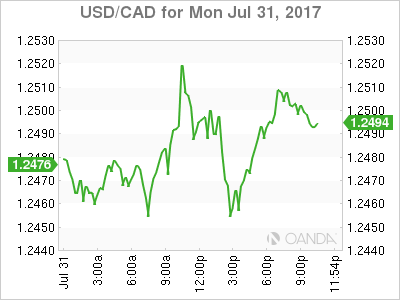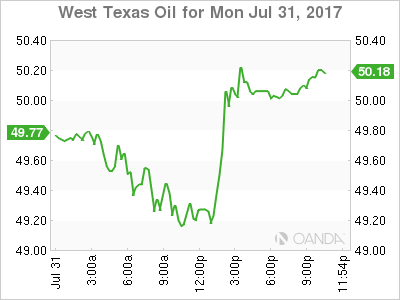The Canadian dollar depreciated on Monday. The loonie started the week on the back foot as raw material and producer prices disappointed with a 3.7 percent and 1.0 percent contractions. Lower energy prices had a negative impact on both indices and will continue to raise question marks if the Bank of Canada (BoC) decides to raise interest rates in October. The CAD has rallied against the USD after a quick turn from neutral to hawk by the Canadian central bank. The July interest rate hike came about after the BoC signalled markets mid June. The bank of expected to follow through in October to leave the benchmark rate at 1.00 percent, the same level that before the two proactive rate cuts in 2015.
The USD is mixed as political drama continues to impair the currency. The reshuffle of the communications team of the Trump Administration ahead of important policy reform pushes and the NAFTA renegotiation talks has boosted the EUR, JPY and CHF against the dollar.
Profit taking and uncertainty around the US possible sanctions to Venezuela have put a stop to the crude rally from last week. Crude ended higher after another weekly drawdown of US crude inventories. Report from US producers of cutting back on capital expenses will limit the pace of rig count growth and could give an advantage to the Organization of the Petroleum Exporting Countries (OPEC) oil cuts that were agreed with other major producers.

The USD/CAD gained 0.412 in the last 24 hours. The currency is trading at 1.2485 after disappointing raw materials and producer prices. Inflation has remained weak even as the economy is on a stronger pace of growth as evidenced by the gross domestic product (GDP) numbers released last week. The Canadian dollar appreciated versus the US dollar on Friday after the GDP in May tripled forecasts. The rebound in oil production put Canadian growth at 0.6 percent beating a forecast of 0.2 percent. Annual growth is 4.6 percent, the fastest since the year 2000.
The loss of momentum of oil prices at the start of the week also put the loonie rally on hold. Weekly inventories in the US have been the main driver and again the American Petroleum Institute (API) and the Energy Information Administration (EIA) releases on Tuesday afternoon and Wednesday will be important in determining crude prices. The high correlation between the Canadian dollar and energy prices is well known and while it has decreased following the efforts to diversify the economy by the government and the central bank it remains an important sector of the economy.
Canadian and American employment data will be a big draw for investors this week. The U.S. non farm payrolls (NFP) could mark a reversal for the USD as once again employment comes to the rescue of the dollar. Low wage growth could reduce the impact of another big headline jobs gain as the Fed grapples with higher monetary policy in a low inflation environment.

Oil lost 0.854 percent on Monday. The price of West Texas Intermediate is trading at $49.32 after profit taking slowed down the black stuff. Last week’s meeting of the Organization of the Petroleum Exporting Countries (OPEC) and other members in Russia reenergized the impact of the production cut agreement. Saudi Arabia pledge to cut even further and emphasized a hardening of compliance vigilance for producers. The political situation in Venezuela could lead to sanctions by the biggest market for their oil, the United States.
The middle of the week inventory releases have been the drivers of oil prices of late. The US rig count has slowed down as producers are rethinking their investments with oil prices range bound. Larger than expected drawdowns have pushed crude to two month highs and is now back to where it was back in May.
Market events to watch this week:
Tuesday, August 1
12:30 am AUD Cash Rate
12:30 am AUD RBA Rate Statement
4:30 am GBP Manufacturing PMI
10:00 am USD ISM Manufacturing PMI
6:45 pm NZD Employment Change q/q
Wednesday, August 2
4:30 am GBP Construction PMI
8:15 am USD ADP Non-Farm Employment Change
10:30 am USD Crude Oil Inventories
9:30pm AUD Trade Balance
Thursday, August 3
4:30 am GBP Services PMI
7:00 am GBP BOE Inflation Report
7:00 am GBP MPC Official Bank Rate Votes
7:00 am GBP Monetary Policy Summary
7:00 am GBP Official Bank Rate
7:30 am GBP BOE Gov Carney Speaks
8:30 am USD Unemployment Claims
10:00 am USD ISM Non-Manufacturing PMI
9:30 pm AUD RBA Monetary Policy Statement
9:30 pm AUD Retail Sales m/m
Friday, August 4
8:30 am CAD Employment Change
8:30 am CAD Trade Balance
8:30 am USD Average Hourly Earnings m/m
8:30 am USD Non-Farm Employment Change













